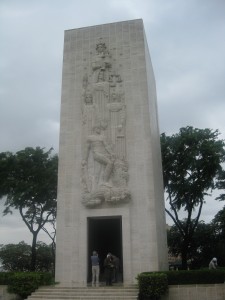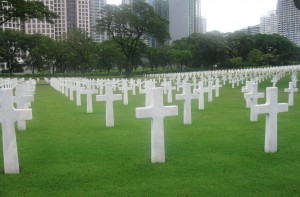 A calm, peaceful escape from the endless traffic; an oasis sitting at the highest point in Fort Bonifacio, you will rarely find more than a handful of visitors at Manila’s American Cemetery and War Memorial. On a rainy day, it is even quieter: just us and a clutch of gardeners.
A calm, peaceful escape from the endless traffic; an oasis sitting at the highest point in Fort Bonifacio, you will rarely find more than a handful of visitors at Manila’s American Cemetery and War Memorial. On a rainy day, it is even quieter: just us and a clutch of gardeners.
I have visited several times, but only recently did I actually hear the bells in the campanile playing. It was positively skin-tingling. As everyone, unbidden, stood silently under umbrellas in the pouring rain (while the gardeners paused from watering the shrubbery), it was reminiscent of our one minute’s silence on Armistice Day, that recalls the end of World War I, which formally ended at the 11th hour of the 11th day of the 11th month of 1918. It was incredibly moving.
Driving though the rows of neat white crosses on manicured, beautifully maintained green lawn, the park is restful on the eye and calming to the spirit. Spread over 152 acres , with wonderful views towards Laguna Bay and the mountains, the cemetery contains 17,201 graves of American and Filipino soldiers killed in World War II, most of whom lost their lives in New Guinea and the Philippines.
 The chapel is housed inside a tall, narrow limestone tower in the centre of a semi-circular colonnade or hemicycle. The altar in the chapel is decorated with mosaic pictures on a predominantly sapphire blue background, that includes a tall, graceful female figure carrying an armful of flowers.
The chapel is housed inside a tall, narrow limestone tower in the centre of a semi-circular colonnade or hemicycle. The altar in the chapel is decorated with mosaic pictures on a predominantly sapphire blue background, that includes a tall, graceful female figure carrying an armful of flowers.
Curving away on either side of the tower are two cloistered walks containing free-standing walls inscribed with the names of 36,285 missing soldiers. Rosettes mark the names of those men who have since been recovered and identified. Carved into the floor are the seals of all the American states. Walking through the broad colonnade of names is both sobering and heart wrenching, and oddly inspirational to see so many men who were prepared to die to protect their country and their core values.
Twenty-five detailed mosaic maps illustrate the various battles fought in the Pacific and Asia, during WWII. It was fascinating to see the scope of the battles, regions in my Euro-centric history lessons that I had never studied.
War is inevitably brutal, but occasionally good things come out of the experience.
 World War II was significant in transforming American attitudes toward Filipinos. At the outbreak of the war, Filipinos were barred from joining the American armed forces. But in 1942, President Franklin D. Roosevelt allowed Filipinos to be drafted into military service, and many Filipinos fought side-by-side with the Americans in Europe and Asia. By the end of the war, the Filipinos had earned the acceptance and admiration of the American public. The Filipinos regained their dignity after many years of discrimination and racism. A later amendment to the Nationality Act of 1940 allowed Filipinos who joined the military to apply for US citizenship. Almost ten thousand Filipinos took this opportunity.
World War II was significant in transforming American attitudes toward Filipinos. At the outbreak of the war, Filipinos were barred from joining the American armed forces. But in 1942, President Franklin D. Roosevelt allowed Filipinos to be drafted into military service, and many Filipinos fought side-by-side with the Americans in Europe and Asia. By the end of the war, the Filipinos had earned the acceptance and admiration of the American public. The Filipinos regained their dignity after many years of discrimination and racism. A later amendment to the Nationality Act of 1940 allowed Filipinos who joined the military to apply for US citizenship. Almost ten thousand Filipinos took this opportunity.
And finally, one American blogger had this to say:
Let us not forget that Filipinos did most of the fighting and most of the dying during the great battle for the Philippines… We Americans celebrate our involvement and lament the suffering of our military personnel… yet often we disregard the unimaginable suffering and devastation that the Filipino people endured in the defense of their liberty…
The memorial is well worth a visit, even in the rain!
*With thanks to my mother for her photographs of the War Memorial.
